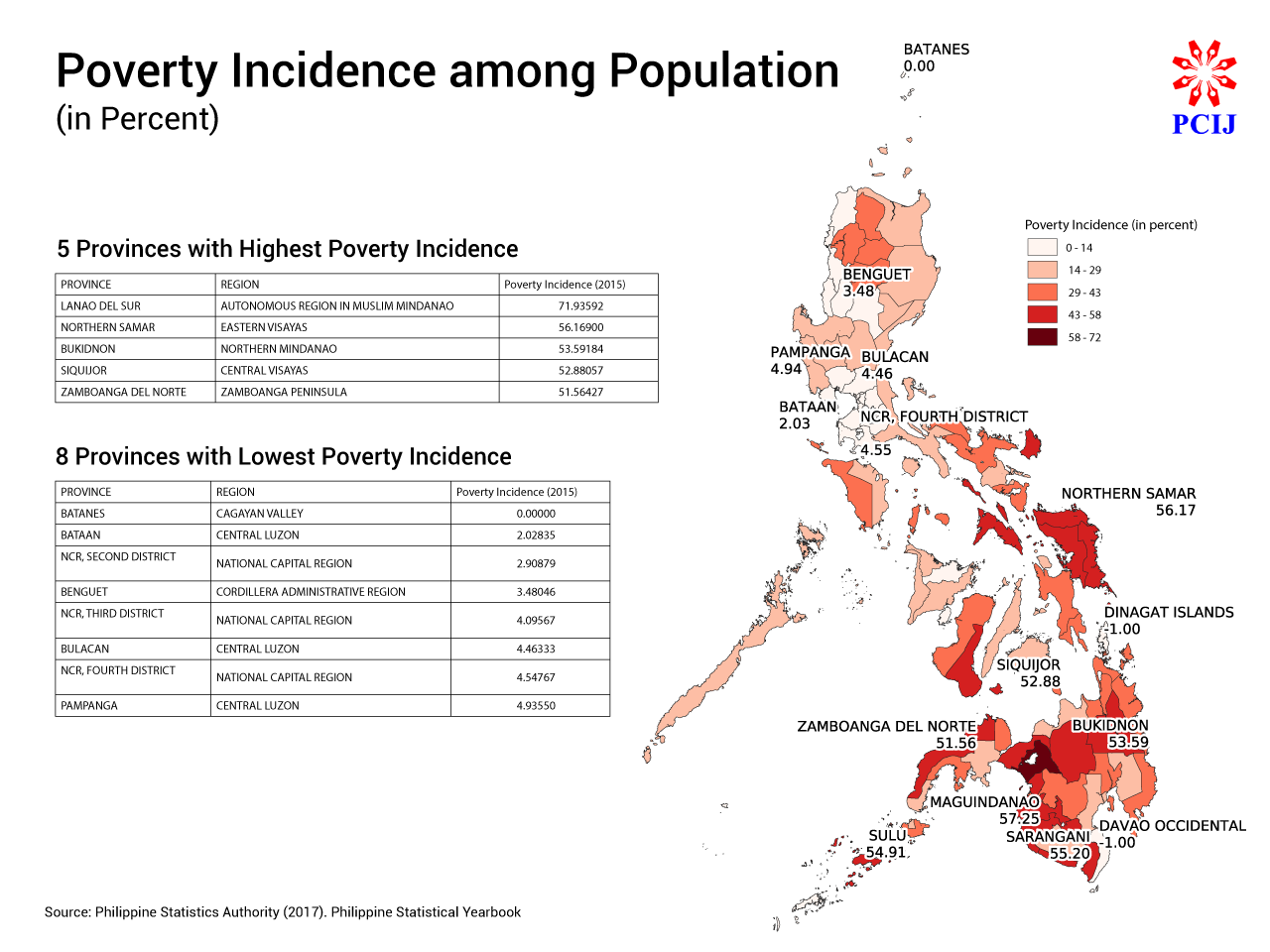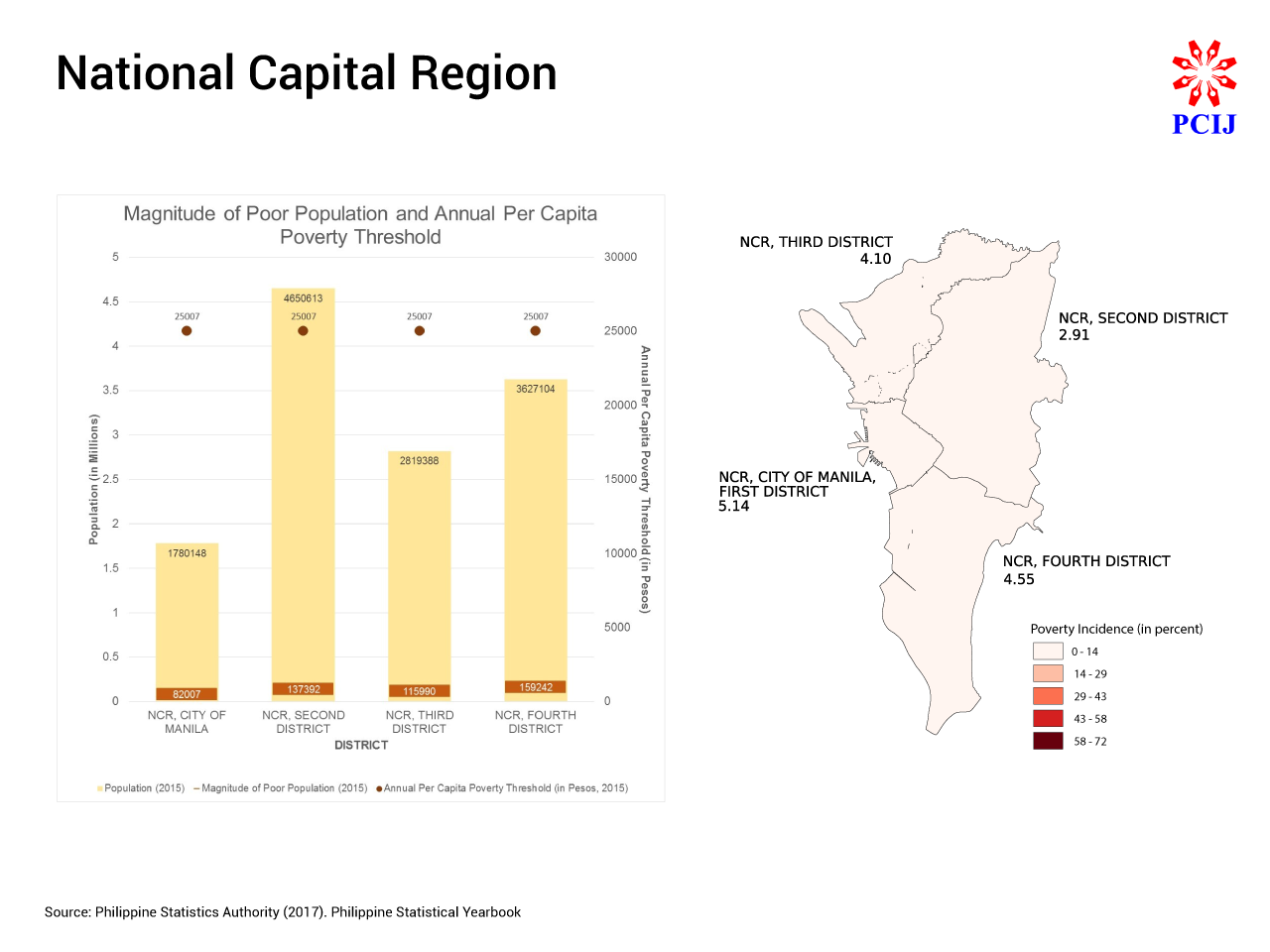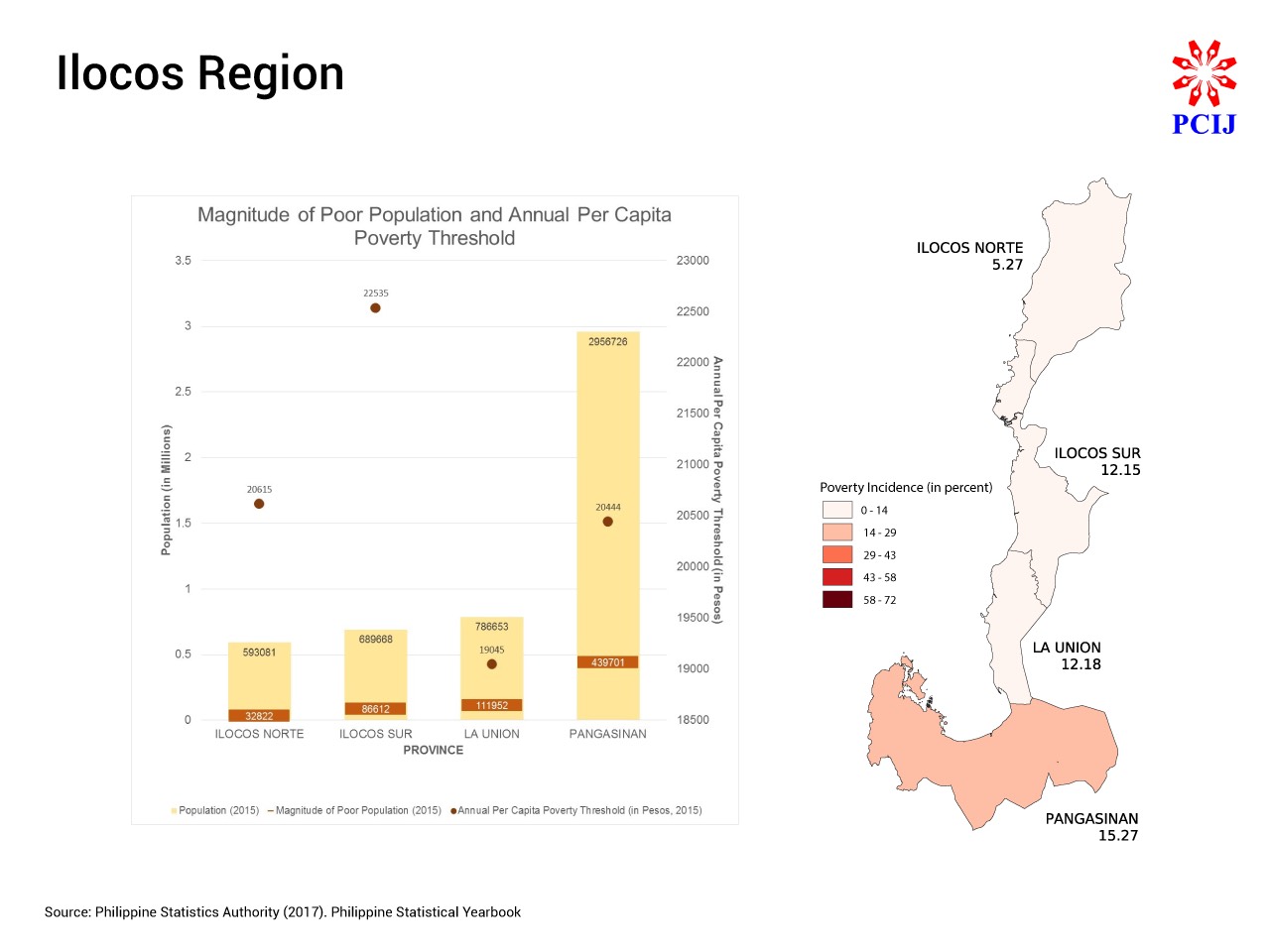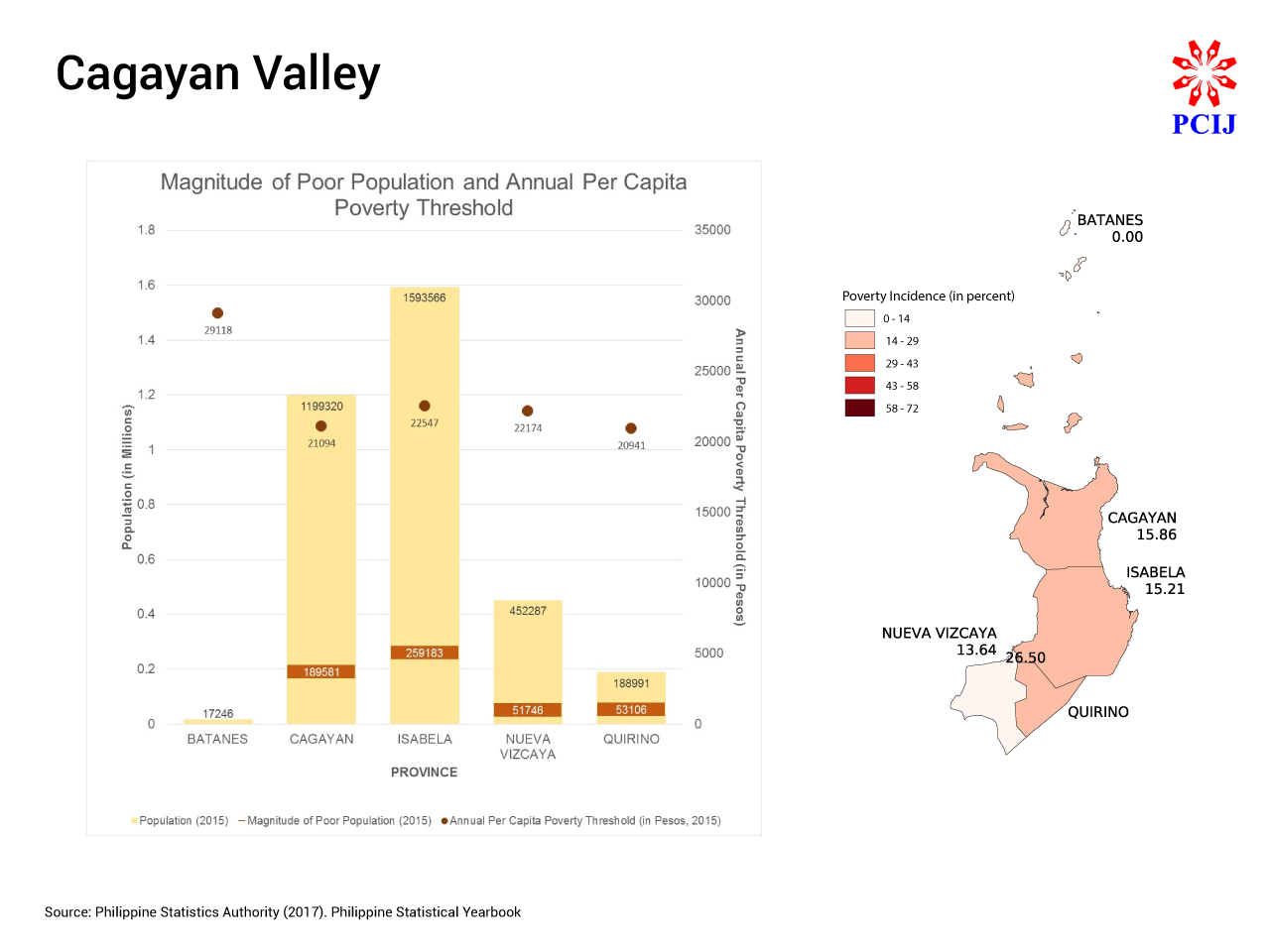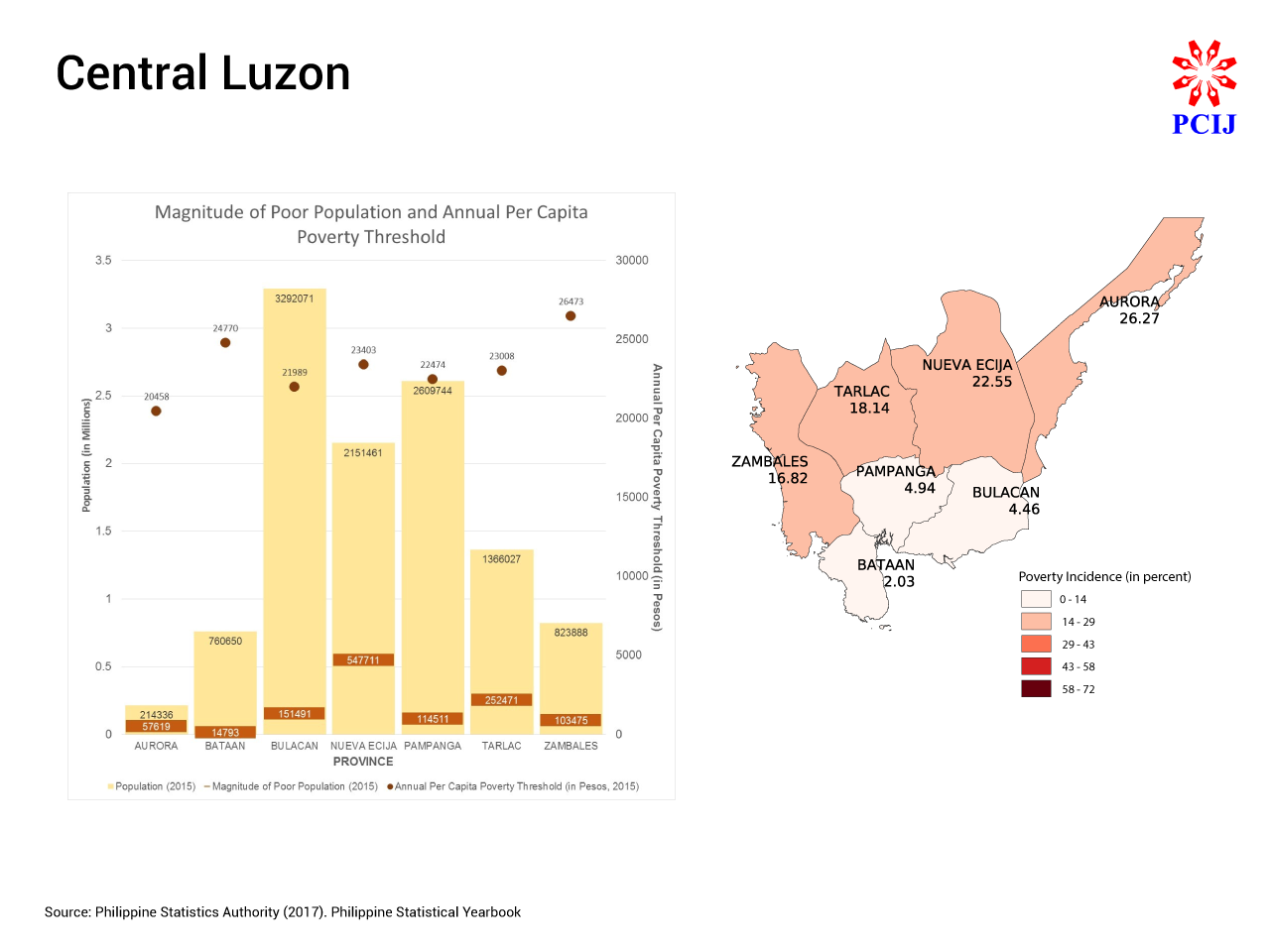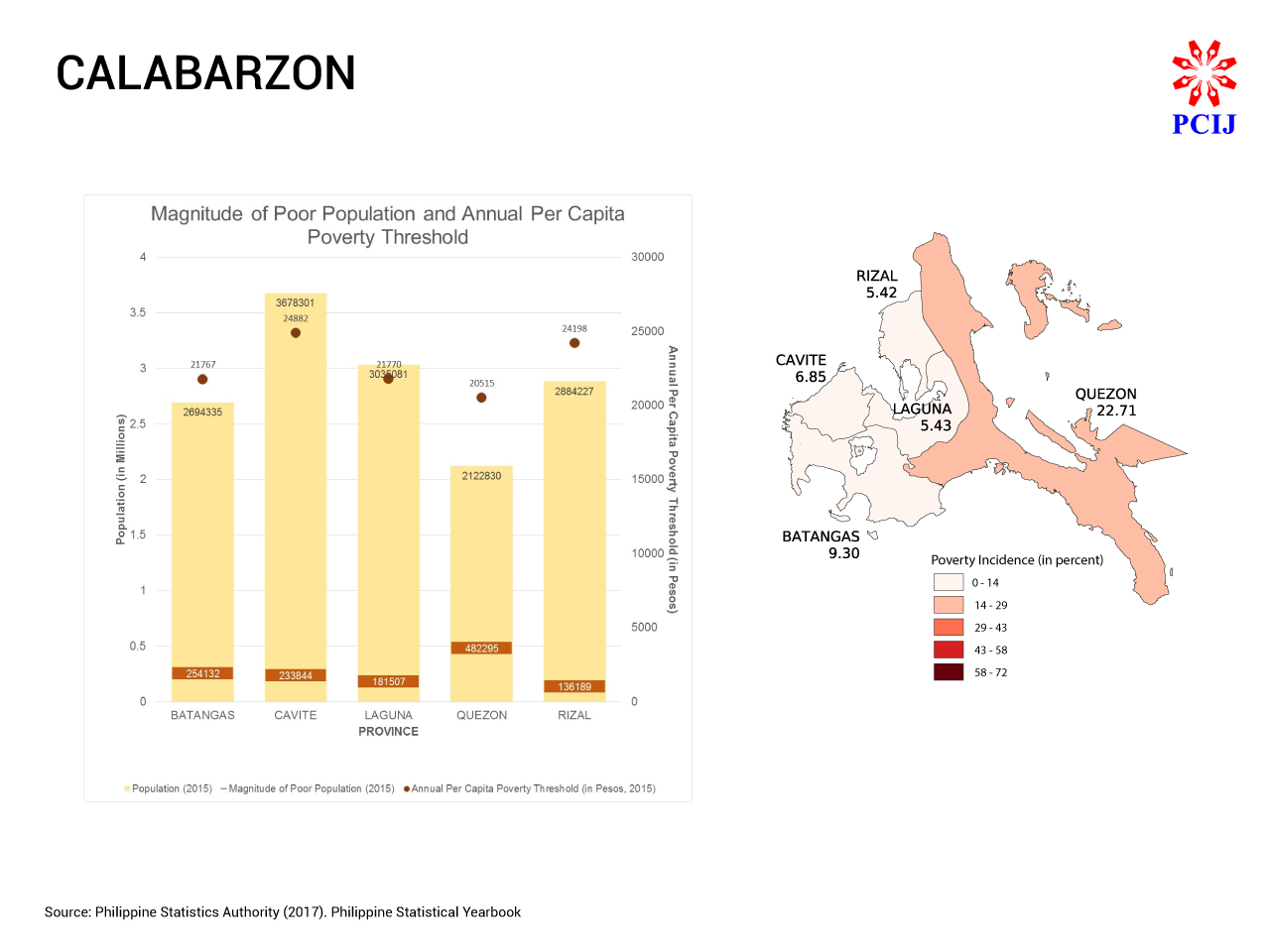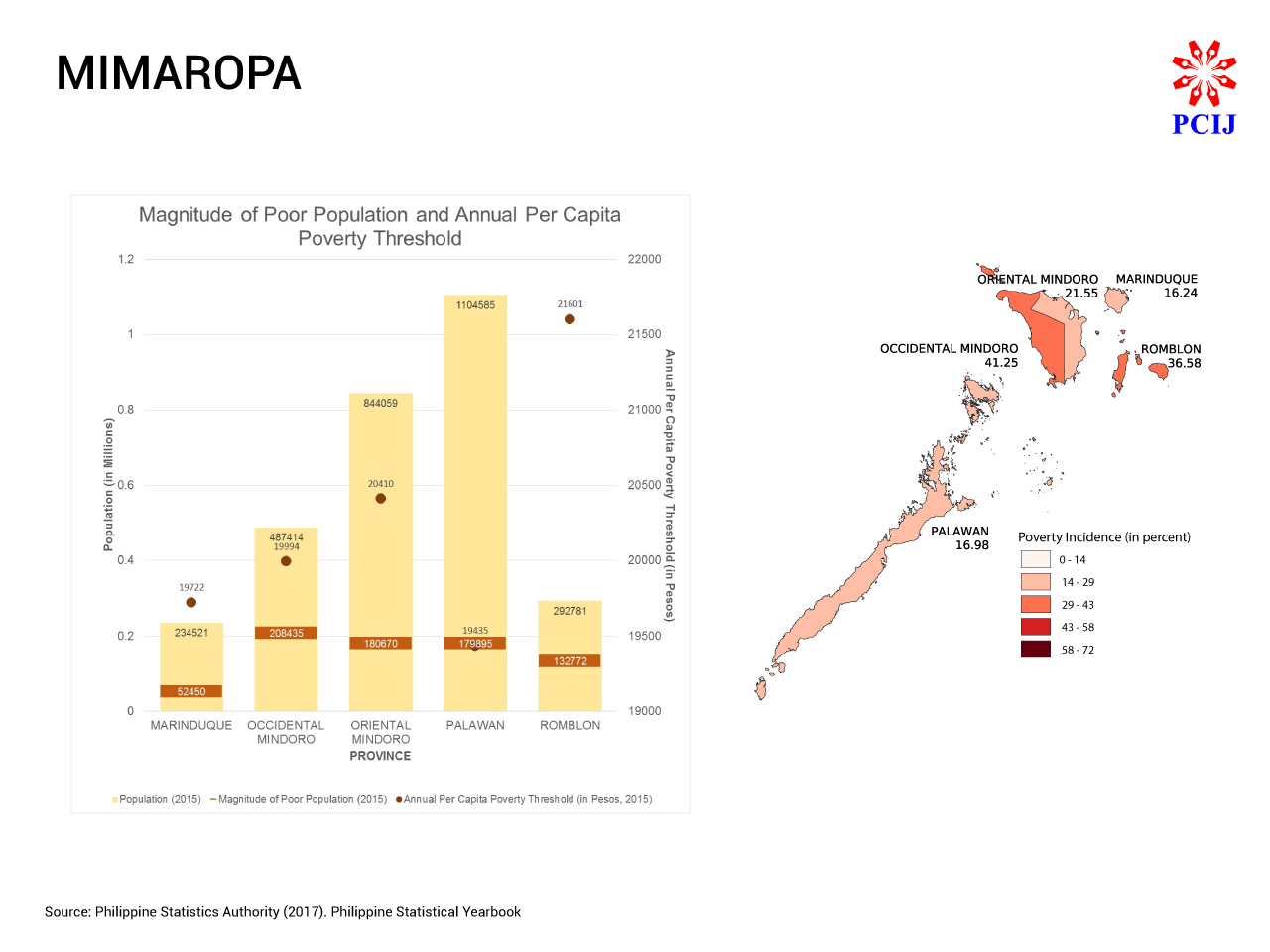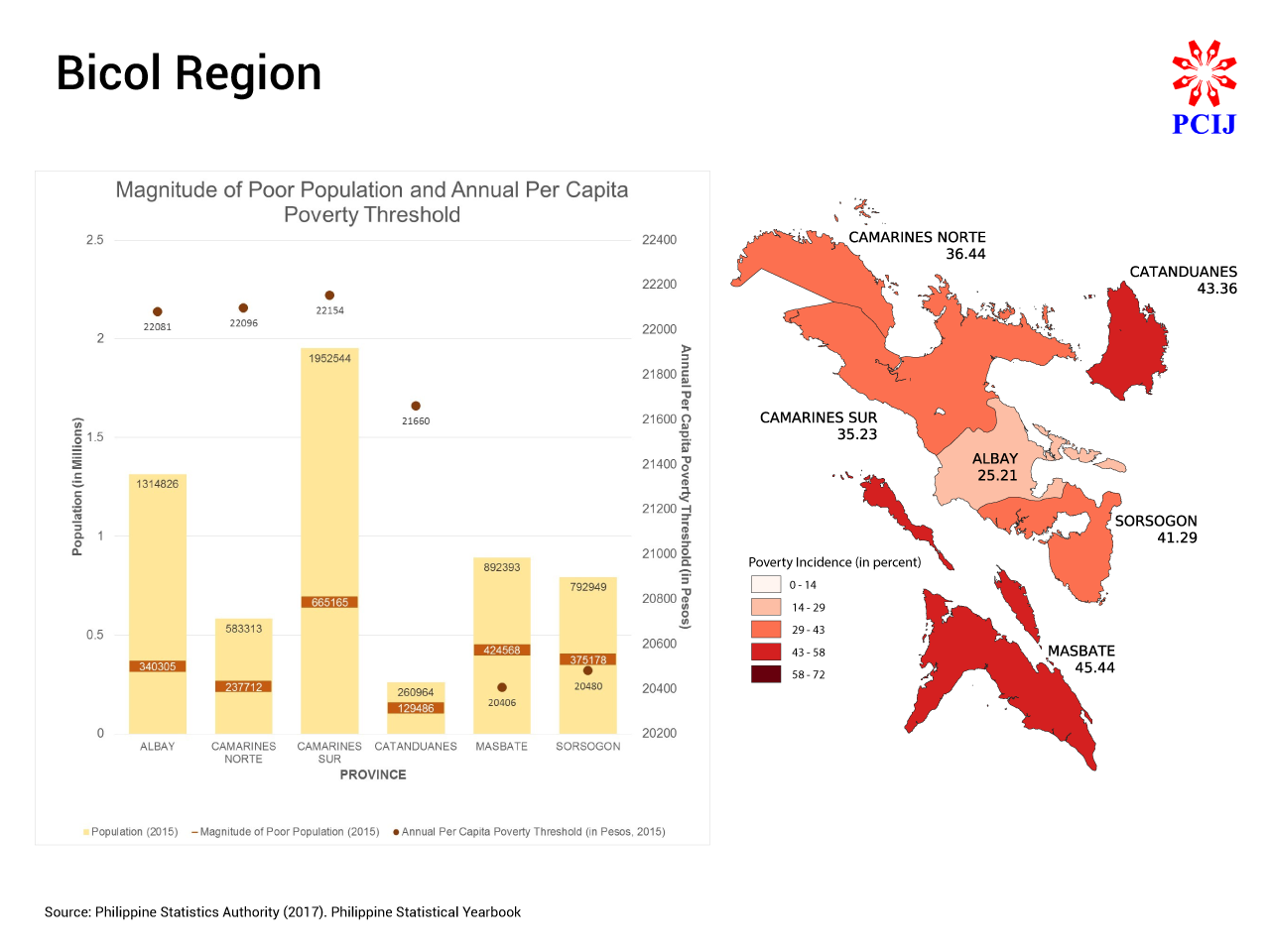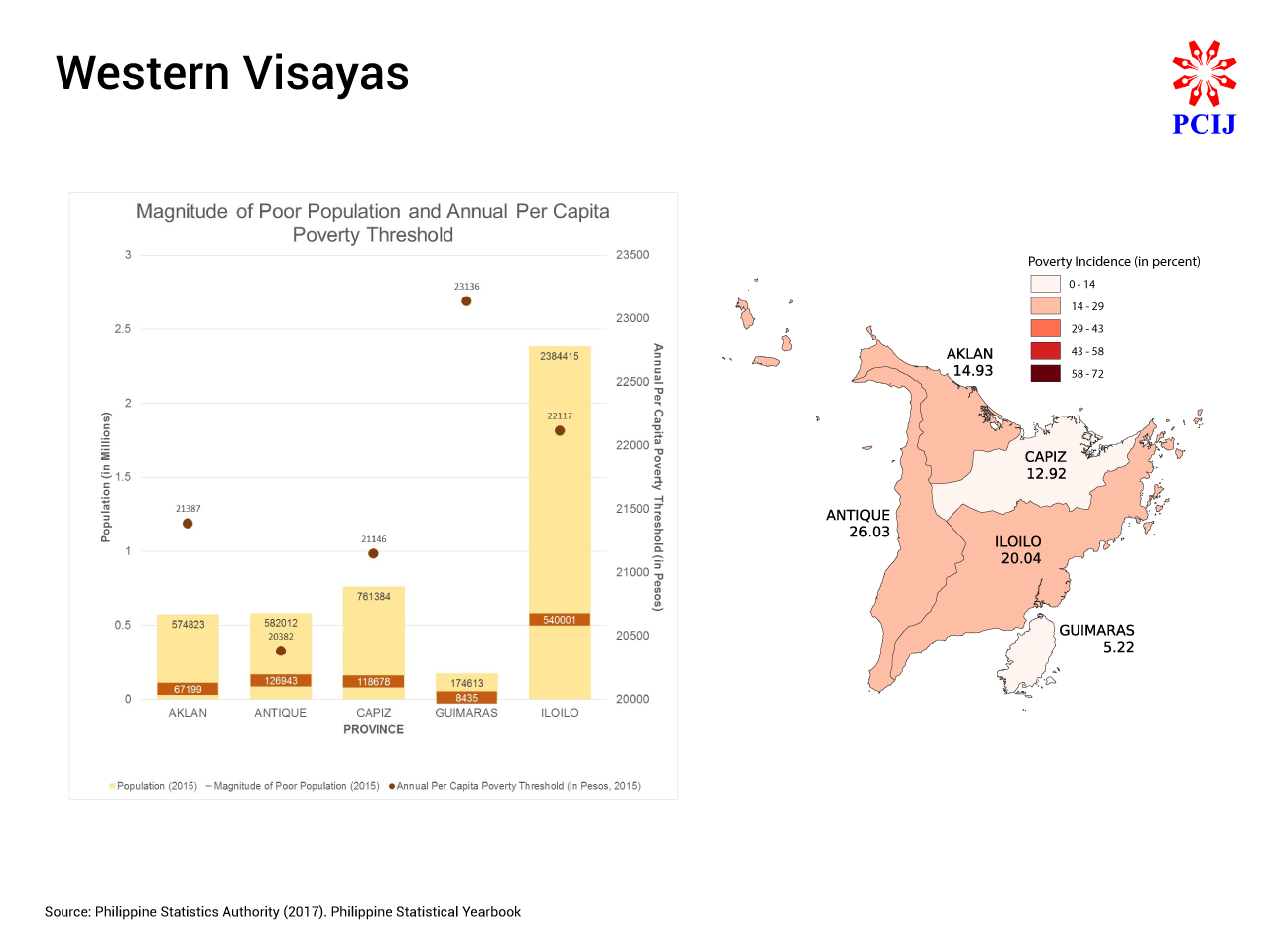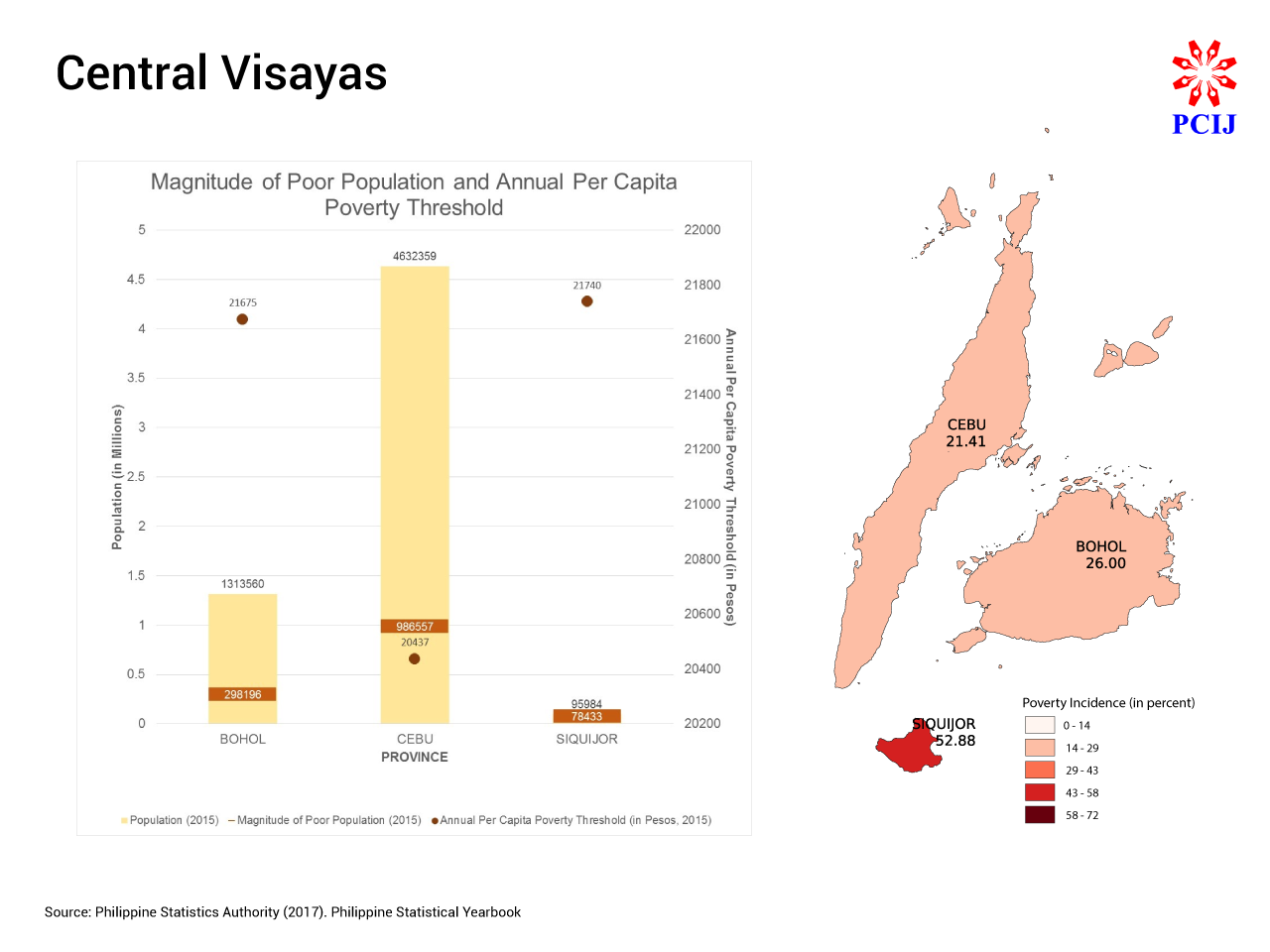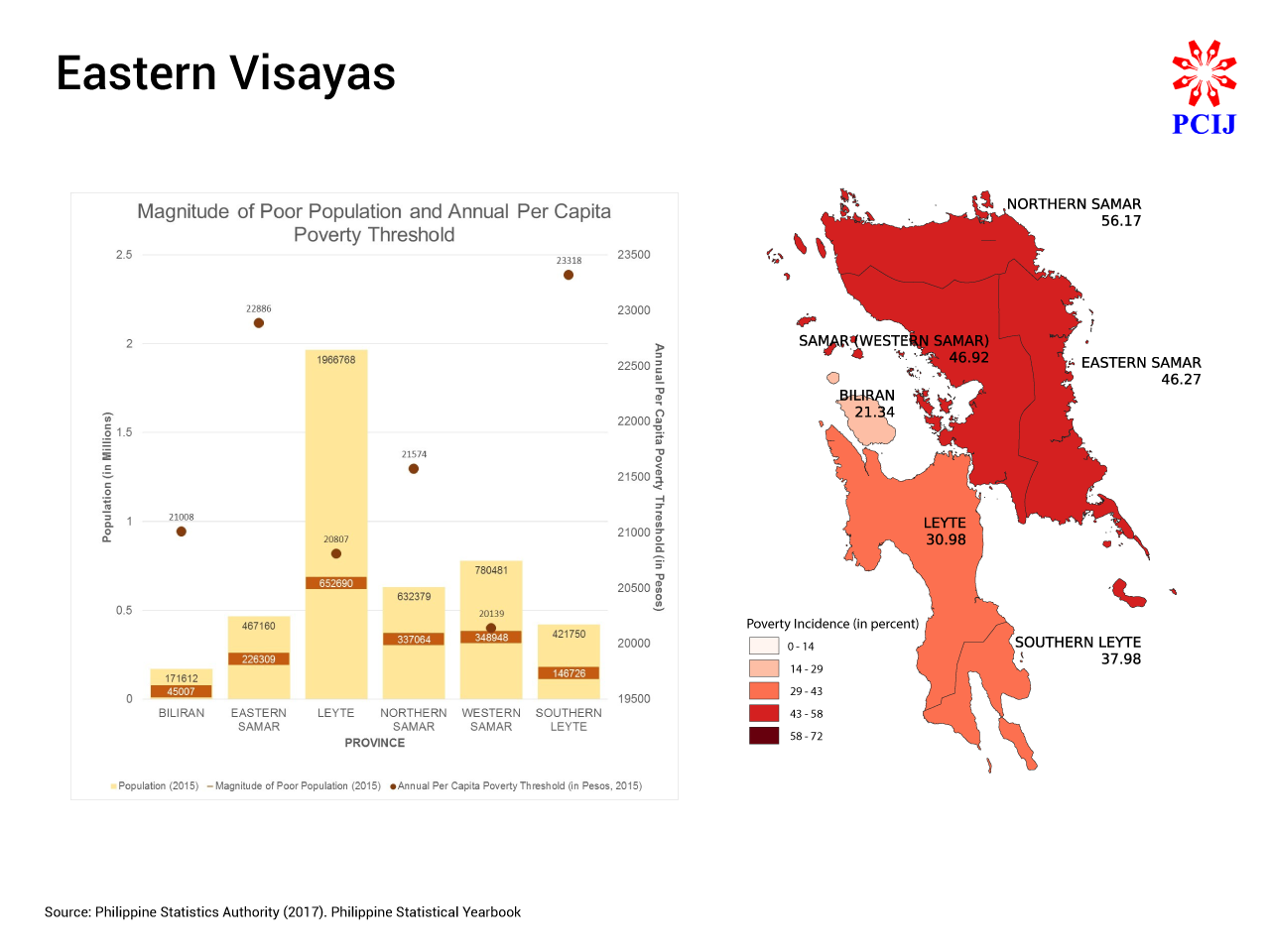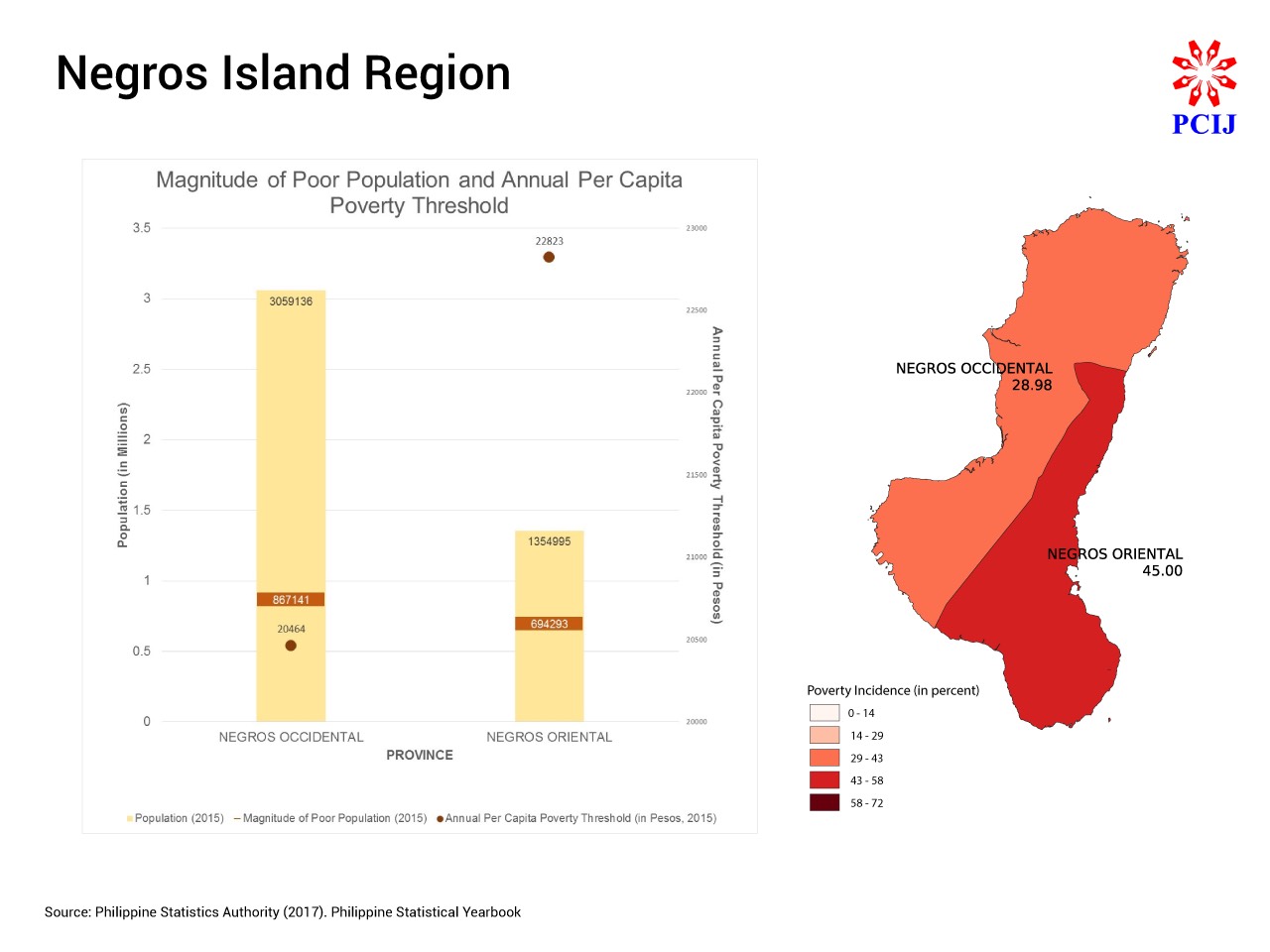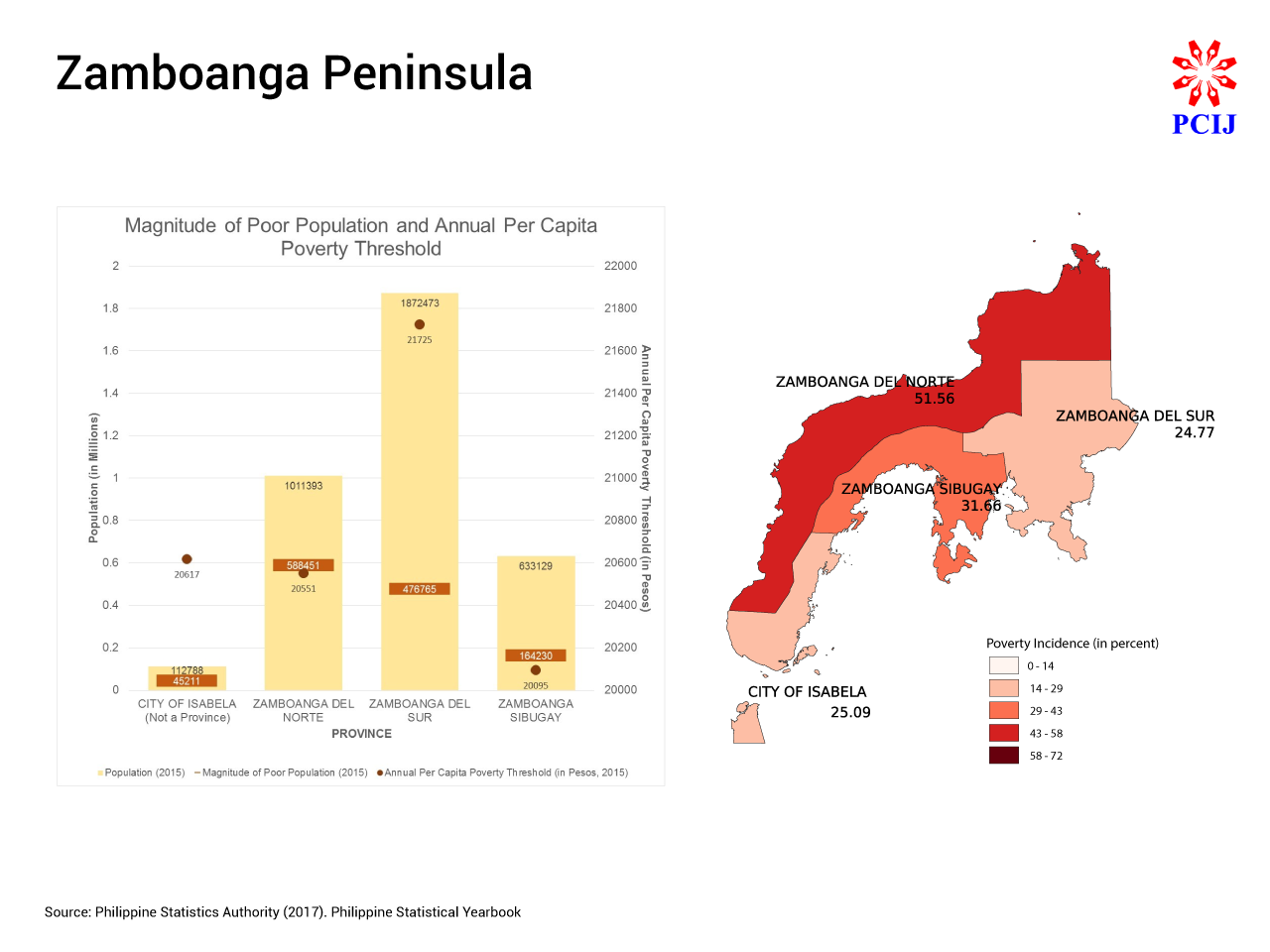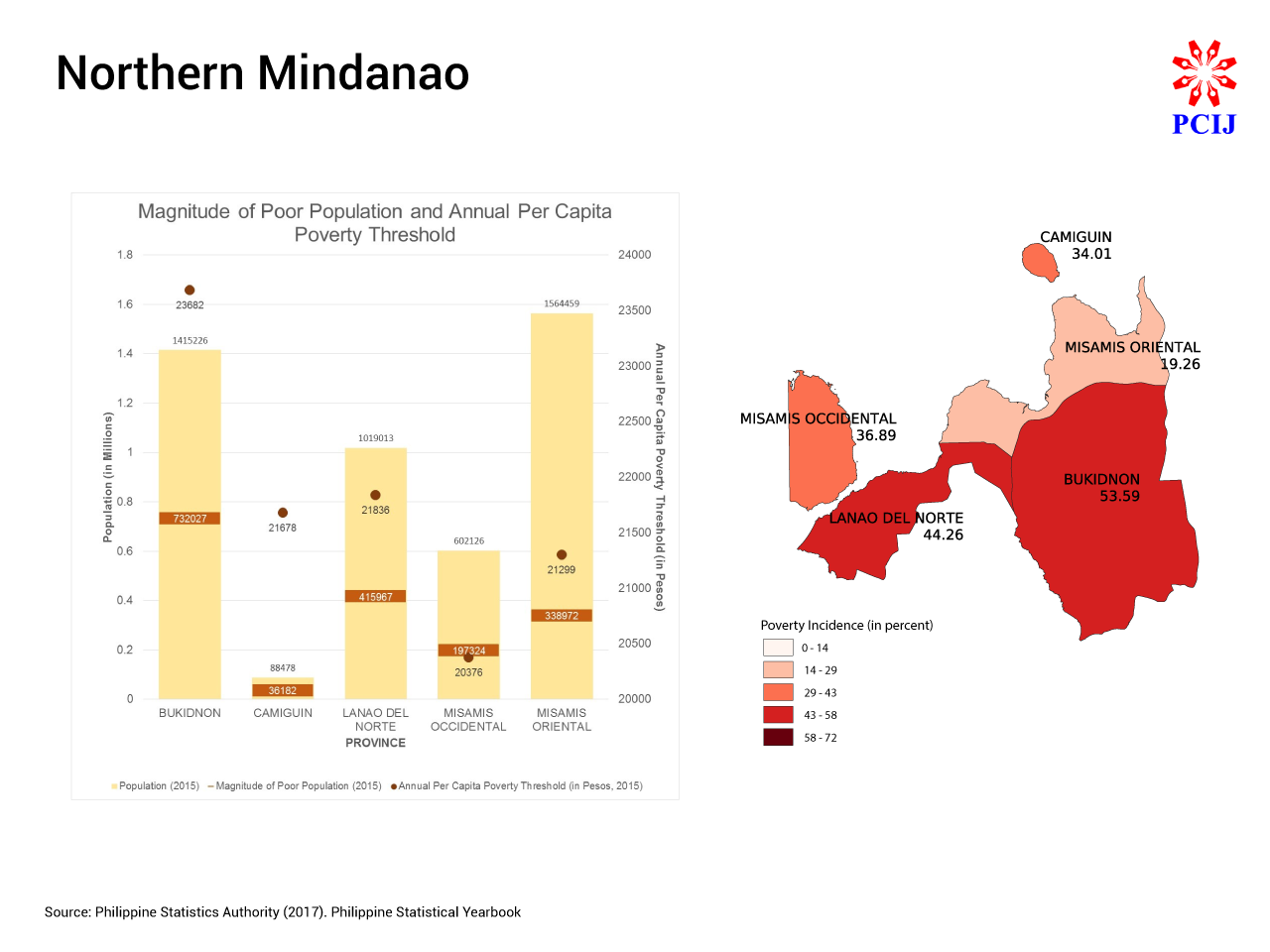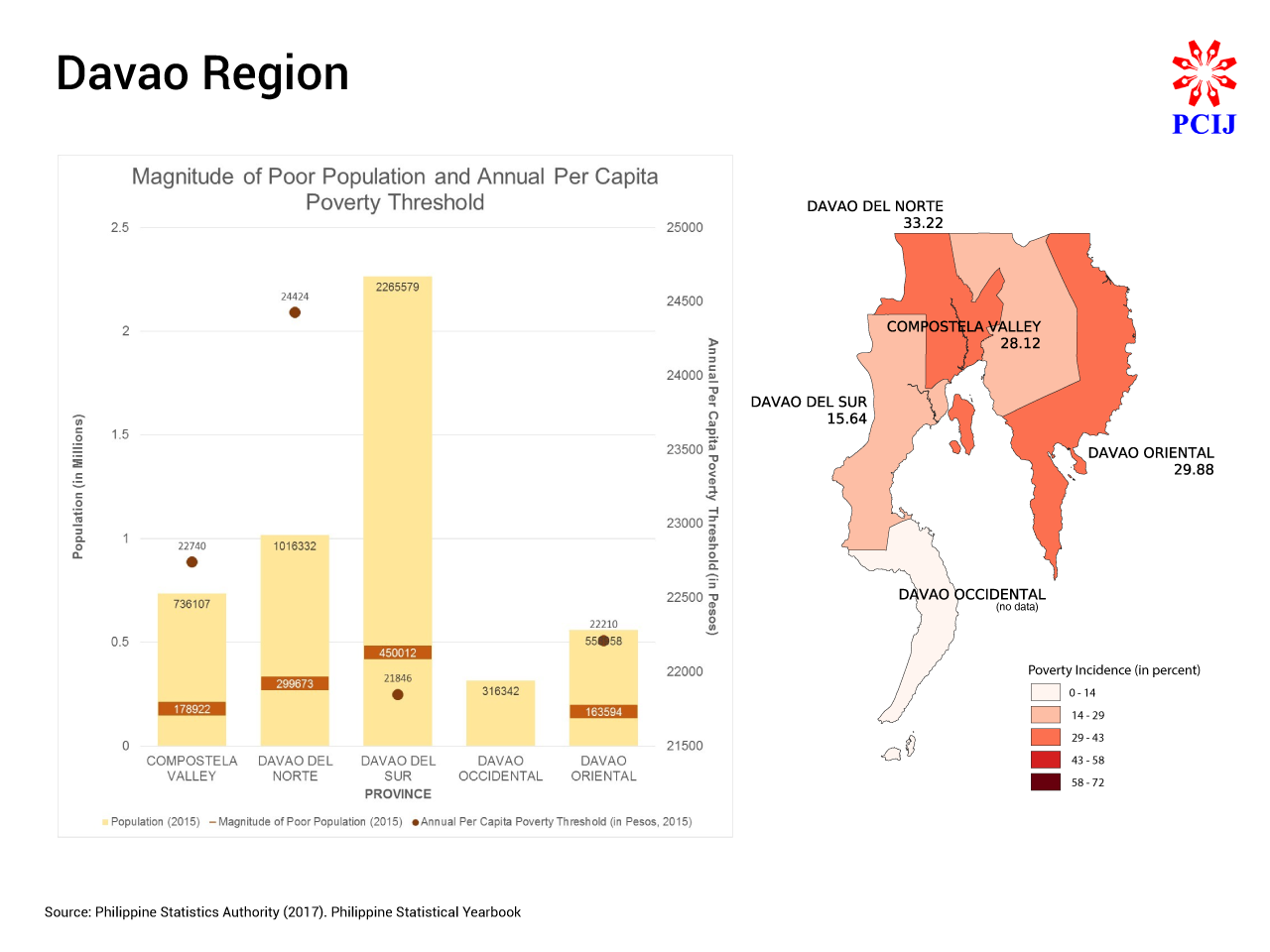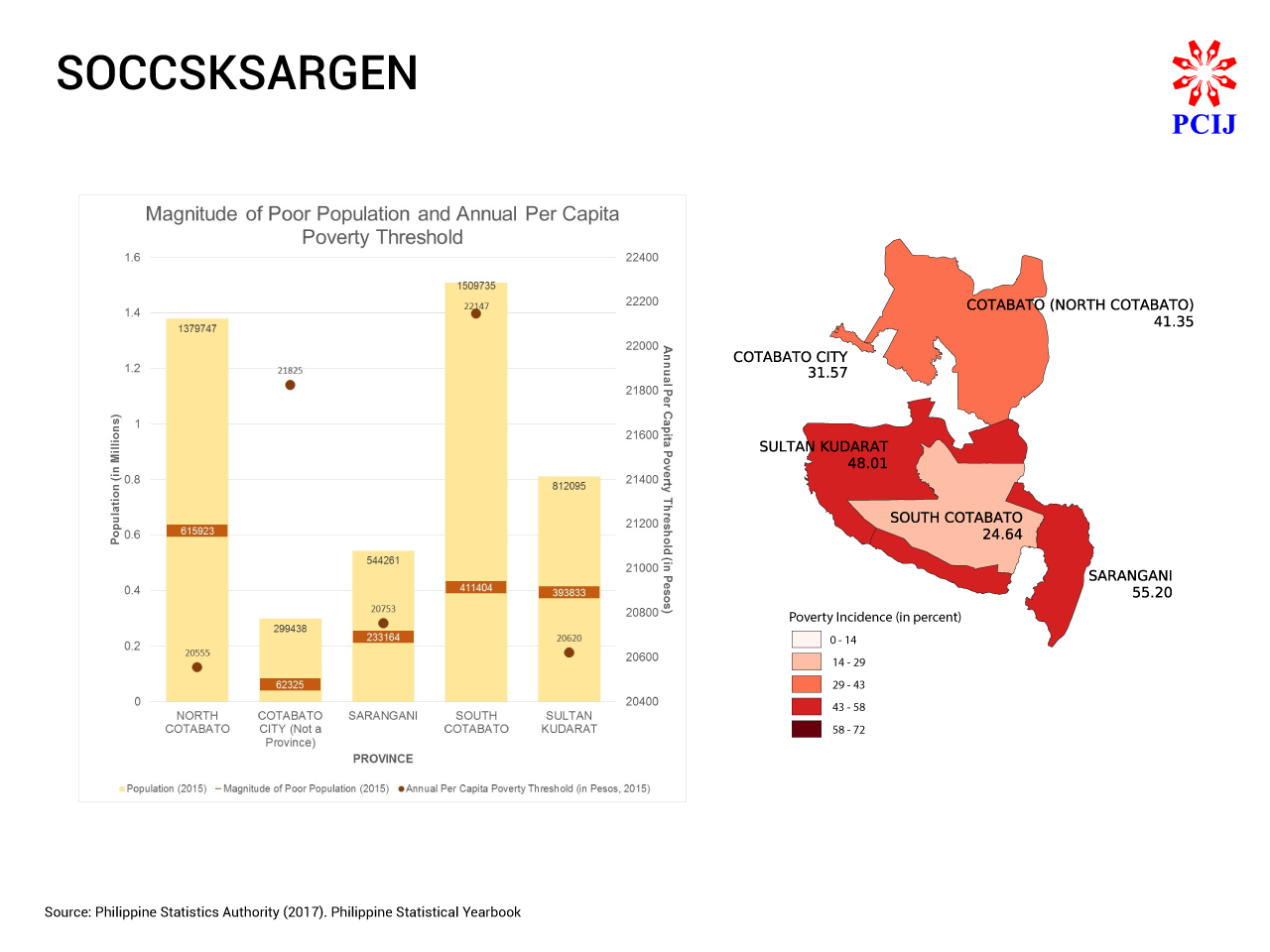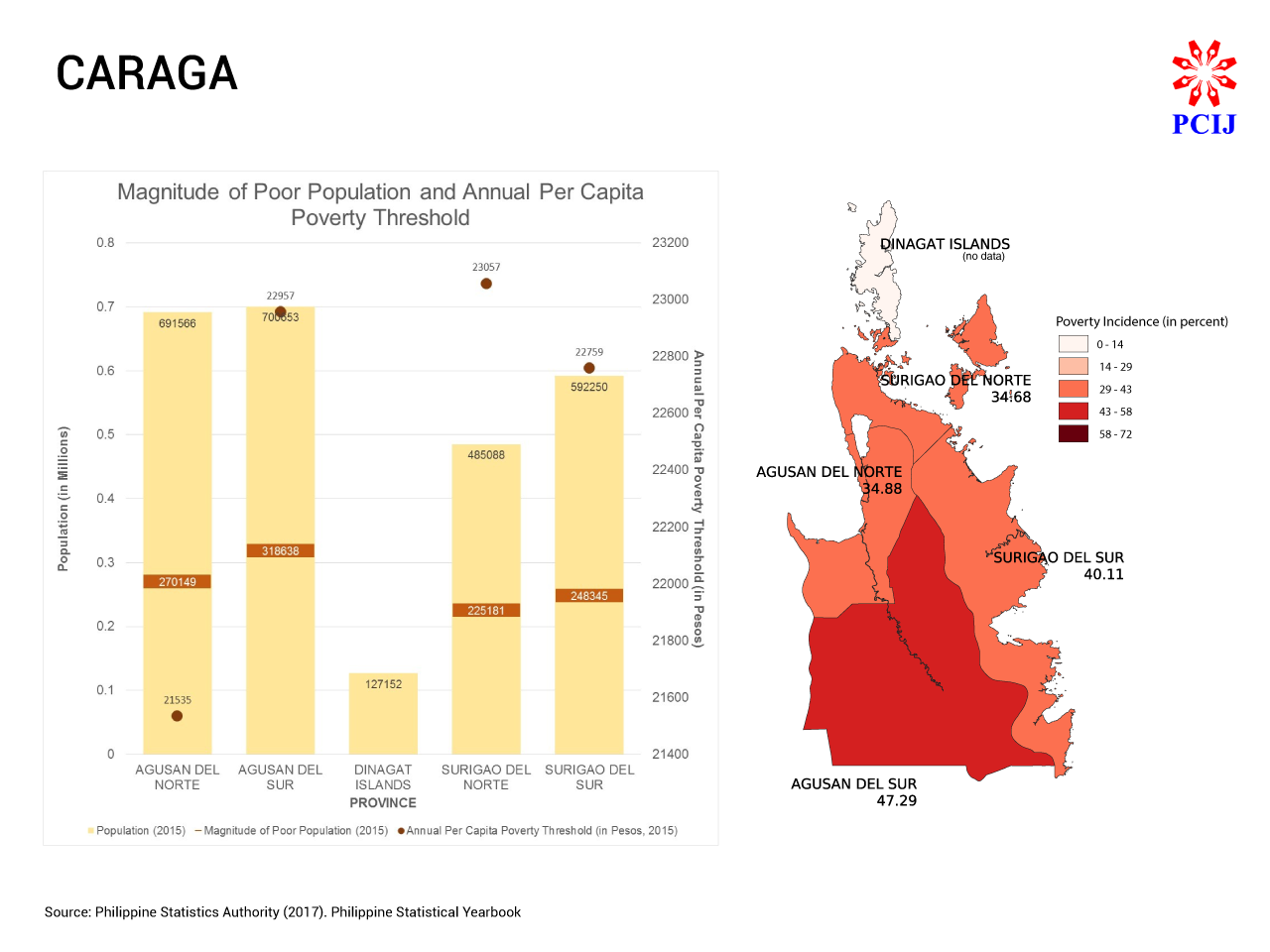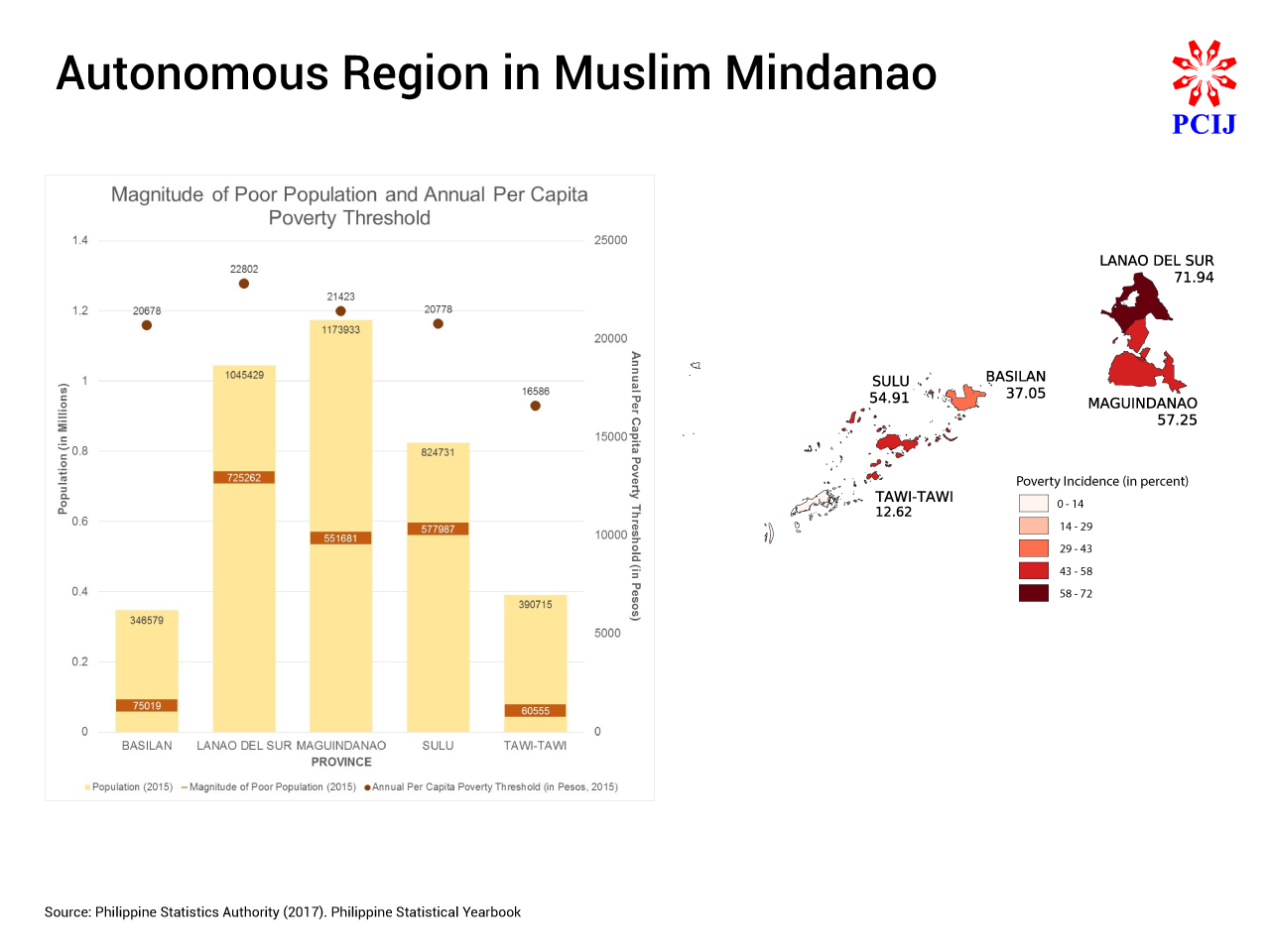THE POOR abound in this country — Filipinos who cannot earn or raise the minimum income to meet the basic food and non-food requirements. The Philippine Statistics Authority (PSA) clusters them among citizens living below the poverty threshold.
Across the nation, the PSA says that some 21.9 million Filipinos, or nearly one in every five, do not earn enough to be able cover his or her basic food and non-food needs.
POVERTY THRESHOLD
As of the 2015 Poverty Census, the national annual per capita poverty threshold is PhP21,753 per individual. This rises to PhP108,765 for a family of five.
In short, the breadwinner of a five-person family must earn PhP9,063.75 at least every month in order to meet his or her brood’s basic food and non-food needs. Failing this, that family is considered to be poor.
Of the proposed 18 federated regions, the National Capital Region (NCR or Metro Manila) had the highest annual per capita poverty threshold at PhP25,007, and MIMAROPA the lowest at PhP20,224. This means that it is most expensive to live above the poverty threshold in NCR, and least expensive in MIMAROPA.
Among the 81 provinces, Batanes had the highest poverty threshold in 2015 at PhP29,118, followed by Zambales at PhP26,473, Cavite at PhP24,882, and Bataan at PhP24,770.
Tawi-Tawi meanwhile had the lowest poverty threshold at PhP16,586, followed by La Union at PhP19,045, Palawan at PhP19,435, Marinduque at PhP19,722, and Occidental Mindoro at PhP19,994.
MAGNITUDE OF POOR POPULATION
Magnitude of the poor refers to the number of families or the population whose annual per capita income falls below the poverty threshold.
According to the 2015 Poverty Census, the magnitude of poor population in the Philippines that year stood at 21.9 million.
By regional spread, Bicol Region has the highest magnitude of poor population among the 18 proposed federated regions, at 2.1 million while Cordillera Administrative Region (CAR) the lowest at 351,590.
Among the provinces, Cebu has the highest magnitude of poor population at 986,557 followed by Negros Occidental at 867,141, Bukidnon at 732,027, Lanao del Sur at 725,262, and Negros Oriental at 694,293.
Guimaras has the lowest magnitude of poor population at 8,435, followed by Bataan at 14,793, Benguet at 28,418, Ilocos Norte at 32,822, and Apayao at 36,004.
POVERTY INCIDENCE
The term poverty incidence, on the other hand, refers to the proportion of individuals with per capita income less than the per capita poverty threshold.
As of the 2015 Poverty Census, poverty incidence in the Philippines stands at 21.6 percent. This means that nearly one out of five Filipinos lives below the poverty line and is considered poor.
Lower poverty thresholds do not necessarily translate to lower poverty incidence. This is because the cost of living in each location must be taken into account to derive both figures.
Thus, despite having the highest annual per capita poverty threshold, NCR has the lowest poverty incidence as of the 2015 Poverty Census, at 3.9 percent.
ARMM or the Autonomous Region in Muslim Mindanao, meanwhile, has the highest poverty incidence at 53.7 percent, which means more than half of ARMM’s population are considered poor.
All but two regions in the Luzon group of islands have poverty incidence lower than the national average.
In contrast, all regions in the Visayas and Mindanao, as well as Luzon’s MIMAROPA and Bicol Region, have poverty incidence numbers that are higher than the national figure of 21.6 percent.
By provincial spread, four of the five poorest provinces are in Mindanao, based on the 2016 Poverty Census.
Lanao del Sur stands out for having the highest poverty incidence rate of 71.94 percent, which means seven in every 10 of its residents endure poverty conditions. Next to Lanao del Sur is Maguindanao, the second poorest in the nation, with a 57.25 percent poverty incidence. Northern Samar in the Visayas comes in third at 56.17 percent followed by Sarangani at 55.2 percent, and Sulu at 54.91 percent.
In most of the Mindanao provinces, too, the poverty incidence is higher than the national average. The only exceptions are Misamis Oriental (19.26 percent), Davao del Sur (15.64 percent), and Tawi-Tawi (12.62 percent).
In the meantime, Luzon hosts four of the five provinces with the lowest poverty incidence rates, according to the 2015 Poverty Census.
These are Bataan, which has the lowest poverty rate at 2.03 percent, followed by Benguet at 3.48 percent, Bulacan at 4.46 percent, and Pampanga at 4.94 percent, with Ilocos Norte at 5.27 percent in fifth place. Guimaras in the Visayas comes in fourth at 5.22 percent.
Despite having the highest poverty threshold among the provinces, Batanes has no one living below poverty threshold and zero poverty incidence as of the 2015 Poverty Census. PSA, however, urges caution in using this estimate due to Batanes’s very small sample size.
HOW THE REGIONS RANK (From poorest to less poor)
NATIONAL CAPITAL REGION (NCR)
Fast Facts: (Rank among 18 regions)
Poverty Incidence: 3.9 percent (No.17)
Magnitude of Poor Population: 494,631 (No. 17)
The National Capital Region will be assigned as the federal capital of the Philippines. For statistical purposes, PSA grouped the 17 cities and single municipality of NCR into four districts: 1st District: City of Manila; 2nd District: Mandaluyong City, Marikina City, Pasig City, Quezon City, San Juan City; 3rd District: Caloocan City, Malabon City, Navotas City, Valenzuela City; and 4th District: Las Pinas City, Makati City, Muntinlupa City, Paranaque City, Pasay City, Pateros, and Taguig City.
Among the proposed federated regions, NCR has the highest poverty threshold at PhP25,007. Despite this, it has the lowest poverty incidence of only 3.9 percent. NCR also has the second lowest magnitude of poor population, with 494,631.
Among NCR’s four districts, however, the city of Manila has the highest poverty incidence at 5.17 percent, followed by the fourth district at 4.55 percent, the third district at 4.1 percent, and the second district at 2.91 percent, as of the 2015 Poverty Census.
NCR’s fourth district has the highest magnitude of poor population with 159,242, followed by the second district with 137,392, the third district with 115,990, and the City of Manila with 82,007.
CORDILLERA ADMINISTRATIVE REGION (CAR)
Fast Facts: (Rank among 18 regions)
Poverty Incidence: 19.7 (No. 12)
Magnitude of Poor Population: 351,590 (No.18)
The Cordillera Administrative Region will comprise the provinces of Abra, Benguet, Ifugao, Kalinga, Apayao, and Mountain Province.
CAR ranks ninth highest among the proposed federated regions in terms of annual per capita threshold at PhP21,770. Its poverty incidence is the sixth lowest among the proposed federated regions at 19.7 percent, even as it has the owest magnitude of poor population, with 351,590.
As of the 2015 Poverty Census, Mountain Province has the highest poverty threshold among the CAR provinces at PhP23,620, followed by Ifugao at PhP22,673, Benguet at PhP21,561, Abra at PhP21,420, Apayao at PhP20,947, and Kalinga at PhP20,468.
Mountain Province also has the highest poverty incidence among the provinces in CAR at 39 percent, followed by Kalinga at 34.9 percent, Apayao at 34.9 percent, Ifugao at 32.5 percent, and Abra at 28.9 percent.
Benguet has the lowest poverty incidence in CAR, and the third lowest in the country, at 3.48 percent. Benguet is also the only CAR province with a poverty incidence lower than the national average.
Kalinga has the highest magnitude of poor population in CAR, with 78,585, followed by Abra with 76,930, Ifugao with 68,321, Mountain Province with 63,332, with 36,004, and Benguet with 28,418.
Benguet and Apayao rank third and fifth, respectively, among the provinces in the country with the lowest poor population.
ILOCOS REGION
Fast Facts: (Rank among 18 regions)
Poverty Incidence: 13.1percent (No.14)
Magnitude of Poor Population: 671,087 (No.15)
The proposed federated region of Ilocos will comprise the provinces of Ilocos Norte, Ilocos Sur, La Union, and Pangasinan.
It has the second lowest annual per capita poverty threshold among the proposed federated regions at PhP20,448, fourth lowest poverty incidence at 13.35 percent and the fourth lowest magnitude of population living below poverty threshold: 671,087.
Ilocos Sur has the highest annual per capita poverty threshold among the provinces in the region, at PhP22,535, followed by Ilocos Norte at PhP20,615, and Pangasinan at PhP20,444.
La Union has the lowest poverty threshold in the region, and the second lowest in the country at PhP19,045.
Meanwhile, Pangasinan has the highest poverty incidence in Ilocos Region at 15.3 percent, followed by La Union at 12.2 percent, and Ilocos Sur at 12.1 percent.
Ilocos Norte has the lowest poverty incidence among the provinces in the region, and the fifth lowest among the provinces in the country at 5.27 percent.
Pangasinan also has the highest magnitude of poor population in Ilocos Region with 439,701, followed by La Union with 111,952, and Ilocos Sur with 86,612.
Ilocos Norte has the lowest magnitude of poor population in the region: 32,822, which is also the fourth lowest in the country.
CAGAYAN VALLEY
Fast Facts: (Rank among 18 regions)
Poverty Incidence: 15.8 percent (No.13)
Magnitude of Poor Population: 553,616 (No.16)
The proposed federated region of Cagayan Valley will comprise the current Region II provinces: namely, Batanes, Cagayan, Isabela, Nueva Vizcaya, and Quirino.
Cagayan Valley ranks eighth highest among the proposed federated regions in terms of annual per capita poverty threshold at PhP21,860.
It has the fifth lowest poverty incidence at 15.8 percent and the third lowest magnitude of poor population, with 553,616.
As of the 2015 Poverty Census, Batanes has the highest poverty threshold – PhP29,118 – not only among the provinces within the region, but also nationwide.
Isabela has the second highest poverty threshold in the region at PhP22,547, followed by Nueva Vizcaya at PhP22,174, Cagayan at PhP21,094, and Quirino at PhP20,941.
In terms of poverty incidence, Quirino ranks the highest among the provinces in Cagayan Valley, at 26.5 percent, followed by Cagayan at 15.9 percent, Isabela at 15.2 percent, and Nueva Vizcaya at 13.6 percent.
Isabela has the highest magnitude of poor population in the region with 259,183, followed by Cagayan with 189,581, Quirino with 53,106, and Nueva Vizcaya with 51,746.
As mentioned previously, Batanes has zero poverty incidence and thus, zero magnitude of poor population, despite having the highest poverty threshold in the region.
CENTRAL LUZON
Fast Facts: (Rank among 18 regions)
Poverty Incidence: 11.2 percent (No.15)
Magnitude of Poor Population: 1.24M (No.10)
The proposed federated region of Central Luzon will comprise the provinces of Aurora, Bataan, Bulacan, Nueva Ecija, Pampanga, Tarlac, and Zambales.
Central Luzon has the second highest annual per capita poverty threshold, next to NCR, at PhP23,200 in 2015. Its poverty incidence is at 11.2 percent; it has the 10th highest magnitude of poor population among the 18 proposed federated regions, with 1,242,071.
As of the 2015 Poverty Census, Zambales has the highest poverty threshold among the provinces in Central Luzon at PhP26,473, followed by Bataan at PhP24,770, Nueva Ecija at PhP23,403, Tarlac at PhP23,008, Pampanga at PhP22,474, Bulacan at PhP21,989, and Aurora at PhP20,458.
Zambales and Bataan rank second and fourth highest, respectively, among all the provinces in the country in terms of poverty threshold.
Despite having the lowest poverty threshold among the provinces in Central Luzon, Aurora has the highest poverty incidence at 26.3 percent, followed by Nueva Ecija at 22.6 percent, Tarlac at 18.1 percent, Zambales at 16.8 percent, Pampanga at 4.94 percent, Bulacan at 4.46 percent, and Bataan at 2.02 percent.
Meanwhile, Nueva Ecija has the highest magnitude of poor population in Central Luzon, with 547,711, followed by Tarlac with 252,471, Bulacan with 151,491, Pampanga with 114,511, Zambales with 103,475, Aurora with 57,619, and Bataan with 14,793.
CALABARZON
Fast Facts: (Rank among 18 regions)
Poverty Incidence: 9.1 percent (No.16)
Magnitude of Poor Population: 1.29M (No.8)
The proposed federated region of CALABARZON will comprise the current provinces in the current Region IV-A namely, Cavite, Laguna, Batangas, Rizal, and Quezon.
CALABARZON ranks sixth highest among the proposed federated regions in terms of annual per capita poverty threshold at PhP22,121 in 2015.
It has the second lowest poverty incidence (9.1 percent) next to NCR, but the eighth highest magnitude of poor population, with 1,287,967.
As of the 2015 Poverty Census, Cavite has the highest poverty threshold among the provinces in CALABARZON, as well as the third highest in the country at PhP24,882, followed by Rizal at PhP24,198, Laguna at PhP21,770, Batangas at PhP21,767, and Quezon at PhP20,515.
Quezon has the lowest poverty threshold among CALABARZON’s provinces, but it has the highest poverty incidence: 22.7 percent. Quezon is also the only province in CALABARZON with poverty incidence that is higher than the national average.
Batangas has the second highest poverty incidence in the region at 9.3 percent, followed by Cavite at 6.85 percent, Laguna at 5.43 percent, and Rizal at 5.42 percent.
Quezon also has the highest magnitude of poor population in the region, with 482, 295, followed by Batangas with 254,132, Cavite with 233,844, Laguna with 181,507, and Rizal with 136,189.
MIMAROPA
Fast Facts: (Rank among 18 regions)
Poverty Incidence: 24.4 percent (No.9)
Magnitude of Poor Population: 754,222 (No.14)
The proposed federated region of MIMAROPA will comprise the provinces in the current Region IV-B: Occidental Mindoro and Oriental Mindoro, Marinduque, Romblon, and Palawan.
MIMAROPA has the lowest annual per capita poverty threshold among the proposed federated regions at PhP20,224 in 2015. It ranks ninth highest in terms of poverty incidence at 24.4 percent, but has the fifth lowest magnitude of poor population with 754,222.
As of the 2015 Poverty Census, Romblon has the highest annual per capita poverty threshold among the provinces in MIMAROPA at PhP21,601, followed by Oriental Mindoro at PhP20,410, Occidental Mindoro at PhP19,994, Marinduque at PhP19,722, and Palawan at PhP19,435.
Moreover, Occidental Mindoro, Marinduque, and Palawan rank third, fourth, and fifth lowest, respectively, among the provinces in the country in terms of annual per capita poverty threshold.
Occidental Mindoro has the highest poverty incidence among the provinces in the region, at 41.2 percent, followed by Romblon at 36.6 percent, Oriental Mindoro at 21.6 percent, Palawan at 17 percent, and Marinduque at 16.2 percent.
Yet still, Occidental Mindoro has the highest magnitude of poor population in MIMAROPA, with 208,435, followed by Oriental Mindoro with 180,760, Palawan with 179,895, Romblon with 132,772, and Marinduque with 52,450.
BICOL REGION
Fast Facts: (Rank among 18 regions)
Poverty Incidence: 36 percent (No.6)
Magnitude of Poor Population: 2.17M (No.1)
The proposed federated region of Bicol will comprise the current Region V provinces: Albay, Camarines Norte, Camarines Sur, Catanduanes, Masbate, and Sorsogon.
Among the proposed federated regions, Bicol’s annual per capita poverty threshold is the seventh lowest at PhP21,476. It has the sixth highest poverty incidence at 36 percent, as well as the highest magnitude of poor population among the proposed federated regions, with 2,172,414.
Camarines Sur has the highest annual per capita threshold among the provinces in Bicol at PhP22,154, followed by Camarines Norte at PhP22,096,Albay at PhP22,081, Catanduanes at PhP21,660, Sorsogon at PhP20,480, and Masbate at PhP20,406.
Despite having the lowest poverty threshold, Masbate has the highest poverty incidence among the provinces in Bicol Region at 45.4 percent, followed by Catanduanes at 43.4 percent, Sorsogon at 41.3 percent, Camarines Norte at 36.4 percent, Camarines Sur at 35.4 percent, and Albay at 25.2 percent.
Camarines Sur has the highest magnitude of poor population among Bicol’s provinces, with 665,165, followed by Masbate with 424,568, Sorsogon with 375,178, Albay with 340,305, Camarines Norte with 237,712, and Catanduanes with 129,486.
WESTERN VISAYAS
Fast Facts: (Rank among 18 regions)
Poverty Incidence: 22.4 percent (No.10)
Magnitude of Poor Population: 861,256 (No.13)
The proposed federated region of Western Visayas will comprise five of the current Region VI’s six provinces: Aklan, Antique, Capiz, Guimaras, and Iloilo.
Among the proposed federated regions, Western Visayas’s annual per capita poverty threshold is the fifth lowest at PhP21,070, based on 2015 data. It has the eighth lowest poverty incidence at 22.4 percent.
Guimaras has the highest annual per capita poverty threshold among the provinces in Western Visayas at PhP23,136, followed by Iloilo at PhP22,117, Aklan at PhP21,384, Capiz at PhP21,146, and Antique at PhP20,382.
Despite having the lowest poverty threshold, Antique has the highest poverty incidence among the provinces in Western Visayas at 26 percent, followed by Iloilo at 20 percent, Aklan at 14.9 percent, and Capiz at 12.9 percent. Guimaras has the lowest poverty incidence among the provinces in the region, at 5.22 percent.
Meanwhile, Iloilo has the highest magnitude of poor population, with 540,001, followed by Antique with 126,943, Capiz with 118,678, Aklan with 67,199.
Guimaras has the lowest magnitude of poor population – 8,435 — not just among the provinces in Western Visayas, but in the whole country as well.
CENTRAL VISAYAS
Fast Facts: (Rank among 18 regions)
Poverty Incidence: 27.6 percent (No.8)
Magnitude of Poor Population: 1.36M (No.7)
The proposed federated region of Central Visayas will have three of the current Region VII’s four provinces: Bohol, Cebu, and Siquijor.
Central Visayas ranks seventh highest among the proposed federated region in terms of annual per capita poverty threshold, with its figure at PhP21,914 in 2015. It has the eighth highest poverty incidence at 27.6 percent.
As of the 2015 Poverty Census, Cebu has the highest annual per capita poverty threshold among the provinces in Central Visayas at PhP21,470, followed by Siquijor at PhP21,675, and Bohol at PhP20,437.
Meanwhile, Siquijor has the highest poverty incidence among the region’s provinces at 53 percent, followed by Bohol at 26 percent, and Cebu at 21 percent.
Cebu also has the highest magnitude of poor population not only among the provinces in Central Visayas, but also in the whole country, with 986,557. It is followed by Bohol with 298,196 and Siquijor with 78,433.
EASTERN VISAYAS
Fast Facts: (Rank among 18 regions)
Poverty Incidence: 38.7 percent (No.3)
Magnitude of Poor Population: 1.76M (No.3)
The proposed federated region of Eastern Visayas will comprise the current Region VIII provinces: Eastern Samar, Northern Samar, Western Samar, Leyte, Southern Leyte, and Biliran.
Among the proposed federated regions, Eastern Visayas’s average annual per capita poverty threshold is the sixth lowest at PhP21,304 in 2015. It ranks third in terms of poverty incidence after ARMM and Caraga, posting a figure of 38.7 percent. It also has the third highest magnitude of poor population, after Bicol and ARMM, with 1,756,744.
As of the 2015 Poverty Census, Southern Leyte has the highest annual per capita poverty threshold among the provinces in Eastern Visayas at PhP23,318, followed by Eastern Samar at PhP22,886, Northern Samar at PhP21,574, Biliran at PhP21,008, Leyte at PhP20,807, and Western Samar at PhP20,139.
Northern Samar has the highest poverty incidence among the provinces in Eastern Visayas, and the third highest among all the provinces in the country at 56.2 percent. Western Samar has the second highest poverty incidence in the region at 46.9 percent, followed by Eastern Samar at 46.3 percent, Southern Leyte at 38 percent, Leyte at 31 percent, and Biliran at 21.3 percent.
Leyte has the highest magnitude of poor population among the provinces in Eastern Visayas, with 652,690, followed by Western Samar with 348,948, Northern Samar with 337,064, Eastern Samar with 226,309, Southern Leyte with 146,726, and Biliran with 45,007.
NEGROS ISLAND REGION
Fast Facts: (Rank among 18 regions)
Poverty Incidence: no data available as yet
Magnitude of Poor Population: no data available as yet
The proposed federated region of Negros Island (NIR) will comprise the provinces of Negros Occidental (formerly of Region VI) and Negros Oriental (formerly of Region VII). NIR was established under then President Benigno S. Aquino III’s Executive Order No. 183 in 2015, but this was suspended by President Rodrigo R. Duterte’s EO No. 83 in 2016.
Negros Occidental, the larger of the two Negros provinces in terms of land area and population, has lower annual per capita poverty threshold at PhP20,464, and poverty incidence at 29 percent. Despite this, Negros Occidental still has the second highest magnitude of poor population among the provinces in the country, with 867,141 people living below the poverty threshold.
By comparison, Negros Oriental has higher annual per capita poverty threshold at PhP22,823, and higher poverty incidence at 45 percent. Negros Oriental has the fifth highest magnitude of poor population – 694,293 — among the provinces nationwide.
ZAMBOANGA PENINSULA
Fast Facts: (Rank among 18 regions)
Poverty Incidence: 33.9 percent (No.7)
Magnitude of Poor Population: 1.27M (No.9)
The proposed federated region of Zamboanga Peninsula will comprise not only the current Region IX provinces — Zamboanga del Norte, Zamboanga del Sur, and Zamboanga Sibugay – but also the component city of Isabela, now in the province of Basilan, which is part of ARMM.
Among the proposed federated regions, Zamboanga Peninsula’s annual per capita poverty threshold is the third lowest at PhP20,925. It has the seventh highest poverty incidence at 33.9 percent and the ninth lowest magnitude of poor population, with 1,274,657.
As of the 2015 Poverty Census, Zamboanga del Norte has the highest annual per capita poverty threshold among the provinces in Zamboanga Peninsula at PhP21,725, followed by Zamboanga Sibugay at PhP20,551, and Zamboanga del Sur at PhP20,095. Isabela City has an annual per capita poverty threshold of PhP20,617.
Zamboanga del Norte also has the highest poverty incidence among the provinces in the region at 51.6 percent, followed by Zamboanga Sibugay at 31.7 percent, and Zamboanga del Sur at 24.8 percent. Isabela City has a poverty incidence of 25.1 percent.
Zamboanga del Norte has the highest magnitude of poor population in Zamboanga Peninsula, with 588,451, followed by Zamboanga del Sur with 476,765, and Zamboanga Sibugay with 164, 230. Isabela City’s poor population stands at 45,211.
NORTHERN MINDANAO
Fast Facts: (Rank among 18 regions)
Poverty Incidence: 36.6 percent (No.5)
Magnitude of Poor Population: 1.72M (No.4)
The proposed federated region of Northern Mindanao will comprise the provinces in the current Region X: Bukidnon, Camiguin, Lanao del Norte, Misamis Occidental, and Misamis Oriental.
Northern Mindanao ranks fifth highest among the proposed federated regions in terms of annual per capita poverty threshold, with its figure at PhP22,345. It has the fifth highest poverty incidence at 36.6 percent and the fourth highest magnitude of poor population, with 1,720,472.
As of the 2015 Poverty Census, Bukidnon has the highest annual per capita poverty threshold among the provinces in Northern Mindanao at PhP23,682, followed by Lanao del Norte at PhP21,836, Camiguin at PhP21,678, Misamis Oriental at PhP21,299, and Misamis Occidental at PhP20,376.
Bukidnon also has the highest poverty incidence among the provinces in the region at 53.6 percent, followed by Lanao del Norte at 44.3 percent, Misamis Occidental at 36.9 percent, and Camiguin at 34 percent.
Misamis Oriental has the lowest poverty incidence in the region, at 19.3 percent, and is one of the three provinces in Mindanao with poverty incidence lower than the national average.
Bukidnon has the highest magnitude of poor population among the provinces in Northern Mindanao, as well as the third highest in the country, with 732,027, followed by Lanao del Norte with 415,967, Misamis Oriental with 338,972, Misamis Occidental with 197,324, and Camiguin with 36,182.
DAVAO REGION
Fast Facts: (Rank among 18 regions)
Poverty Incidence: 22 percent (No.11)
Magnitude of Poor Population: 1.09M (No.11)
The proposed federated region of Davao will comprise the current Region XI provinces: Compostela Valley, Davao del Norte, Davao del Sur, Davao Oriental, and Davao Occidental.
Among the proposed federated regions, Davao’s annual per capita poverty threshold is the eighth lowest at PhP22,754, as of 2015. It has the seventh lowest poverty incidence at 22 percent and the eighth lowest magnitude of poor population, with 1,092,201.
Davao del Norte has the highest annual per capita poverty threshold among the provinces in Davao, as well as the fifth highest in the country at PhP24,424, followed by Compostela Valley at PhP22,740, Davao Oriental at PhP22,210, and Davao del Sur at PhP21,846.
Davao del Norte also has the highest poverty incidence among the provinces in the proposed region, clocking in at 33.2 percent, followed by Davao Oriental at 29.9 percent, and Compostela Valley at 28.1 percent.
Davao del Sur, meanwhile, has the lowest poverty incidence among the provinces in Davao, posting 15.6 percent. It is one of only three provinces in Mindanao with a poverty incidence lower than the national average.
Despite this, Davao del Sur has the highest magnitude of poor population among the region’s provinces, with 450,012, followed by Davao del Norte with 299,673, Compostela Valley with 178,922, and Davao Oriental with 163,594.
Davao Occidental, the newest province in the country, was created only in 2013 and was not included in PSA’s 2015 Poverty Census.
SOCCSKSARGEN
Fast Facts: (Rank among 18 regions)
Poverty Incidence: 37.3 percent (No.4)
Magnitude of Poor Population: 1.72M (No.5)
The proposed federated region of SOCCSKSARGEN will comprise the current Region X provinces of South Cotabato, North Cotabato, Sultan Kudarat, and Sarangani, along with the independent component city of Cotabato in the province of Maguindanao, which is now part of ARMM.
Among the proposed federated regions, SOCCSKSARGEN’s annual per capita poverty threshold is the fourth lowest at PhP21,025 in 2015. It has the fourth highest poverty incidence at 37.3 percent and the fifth highest magnitude of poor population, with 1,716,649.
As of the 2015 Poverty Census, South Cotabato has the highest annual per capita poverty threshold among the provinces in SOCCSKSARGEN at PhP22,147, followed by Sarangani at PhP20,753, Sultan Kudarat at PhP20,620, and North Cotabato at PhP20,555. Cotabato City has a poverty threshold of PhP21,825.
Sarangani has the highest poverty incidence – 55.2 percent — among the region’s provinces, and the fourth highest countrywide.
Sultan Kudarat has the second highest poverty incidence at 48 percent, followed by North Cotabato at 41.4 percent, and South Cotabato at 24.6 percent. Cotabato City has a poverty incidence of 31.6 percent.
North Cotabato has the highest magnitude of poor population among the provinces in SOCCSKSARGEN, with 615,923, followed by South Cotabato with 411,404, Sultan Kudarat with 393,833, and Sarangani with 233,164. Cotabato City has a poor population of 62,325.
CARAGA
Fast Facts: (Rank among 18 regions)
Poverty Incidence: 39.1 percent (No.2)
Magnitude of Poor Population: 1.06M (No.12)
The proposed federated region of Caraga will comprise the current Region XIII provinces: Agusan del Norte, Agusan del Sur, Surigao del Norte, Surigao del Sur, and the Dinagat Islands.
Among the proposed federated regions, Caraga has the fourth highest annual per capita poverty threshold at PhP22,570 in 2015. It has second highest poverty incidence, after ARMM, at 39.1 percent and the seventh lowest magnitude of poor population, with 1,062,313.
As of the 2015 Poverty Census, Surigao del Norte has the highest poverty threshold among the provinces in Caraga at PhP23,057, followed by Agusan del Sur at PhP22,957, Surigao del Sur at PhP22,759, and Agusan del Norte at PhP21,535.
Agusan del Sur has the highest poverty incidence at 47.3 percent, followed by Surigao del Sur at 40.1 percent, Agusan del Norte at 34.9 percent, and Surigao del Sur at 34.7 percent.
Agusan del Sur also has the highest magnitude of poor population in the region, with 318,638, followed by Agusan del Norte with 270,149, Surigao del Sur with 248,345, and Surigao del Norte with 225,181.
Dinagat Islands was not included in PSA’s 2015 Poverty Census.
AUTONOMOUS REGION IN MUSLIM MINDANAO
Fast Facts: (Rank among 18 regions)
Poverty Incidence: 53.7 percent (No.1)
Magnitude of Poor Population: 1.99M (No.2)
The Autonomous Region in Muslim Mindanao (ARMM) will comprise the provinces of Basilan (excluding the city of Isabela), Lanao del Sur, Maguindanao (excluding Cotabato City), Sulu, and Tawi-Tawi.
Among the proposed federated regions, ARMM’s average annual per capita poverty threshold is the eighth lowest at PhP21,563 as of 2015. Despite this, ARMM has the highest poverty incidence at 53.7 percent and the second highest magnitude of poor population, with 1,990,504.
Lanao del Sur has the highest annual per capita poverty threshold among the provinces in ARMM at PhP22,802, followed by Maguindanao at PhP21,423, Sulu at PhP20,778, and Basilan at PhP20,678.
Tawi-Tawi’s poverty threshold of PHP16,586 is the lowest not just in ARMM, but also in the whole country.
But it is Lanao del Sur that stands out for having the highest poverty incidence, not only in ARMM but in the whole country, at 71.9 percent.
Lanao del Sur also has the highest magnitude of poor population among the provinces in ARMM, as well as the fourth highest in the country, with 725,262, followed by Sulu with 577,987, Maguindanao with 551,681, Basilan with 75,019, and Tawi-Tawi with 60,555.
In the meantime, the province of Maguindanao ranks second poorest in the country at 57.2 percent, followed by Sulu at 54.9 percent, and Basilan at 37 percent.
And then there is Tawi-Tawi, whose poverty incidence of 12.6 percent makes it the only province in ARMM and one of only three provinces in Mindanao with a poverty incidence lower than the national average. — PCIJ, July 2018
———————————————————————————————————————————————————————————————
To browse more data on the Philippines across periods of time, check out PCIJ’s MoneyPolitics Online!
